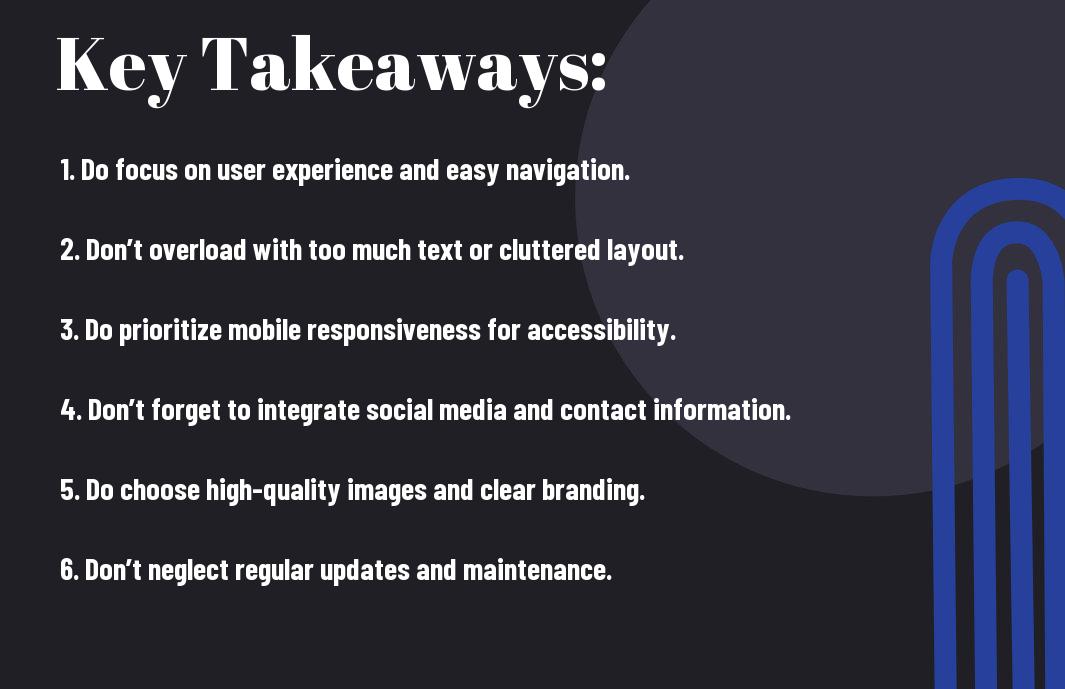Embarking on creating a website for your small business can be an overwhelming task, but it doesn’t have to be. When it comes to designing a website for your small business, there are key dos and don’ts that you should keep in mind to ensure that your website effectively represents your brand and drives business growth. In this blog post, we will discuss the critical elements of small business website design, as well as the common mistakes to avoid. By the end of this post, you will have a clear understanding of what it takes to create a successful website for your small business.
Key Takeaways:
- Simple Navigation: A clear and user-friendly navigation design is essential for guiding visitors through the website and helping them find the information they need.
- Responsive Design: Ensure that the website is fully optimized for mobile devices to accommodate the increasing number of users accessing websites from their smartphones and tablets.
- Compelling Content: High-quality and engaging content is crucial for capturing the attention of visitors and convincing them to explore further or make a purchase.
- Professional Visuals: Use professional images and graphics to create a polished and visually appealing website that reflects the professionalism of the business.
- Optimized for SEO: Implementing proper SEO techniques is vital for ensuring that the website ranks well in search engine results and drives organic traffic to the business.

Website Design Dos
While designing a small business website, there are several important factors to keep in mind to ensure a positive user experience and effective online presence. For a comprehensive list of dos and don’ts, you can refer to What are the Do’s and Don’ts of a Small Business Website? to get more in-depth insights. Here are some key dos to consider when designing your website:
Prioritize User Experience (UX)
When building your small business website, prioritize user experience (UX) to ensure that visitors can easily navigate and find what they are looking for. Your site should be organized and intuitive, with clear navigation and information architecture. Make sure your website is easy to use, visually appealing, and loads quickly to keep visitors engaged.
Implement Responsive Design
It’s crucial to implement responsive design to ensure that your website looks and functions well on various devices, including smartphones and tablets. By utilizing responsive design, you can provide an optimal viewing experience for your visitors, regardless of the device they use to access your site.
Focus on Loading Speed and Performance
Optimize your website for loading speed and performance to provide a seamless browsing experience for your visitors. Fast-loading websites are essential for retaining visitors and improving your search engine rankings. Ensure that your website loads quickly, and optimize images and content to minimize loading times.
Include Clear Call-to-Action (CTA)
Include clear and compelling calls-to-action (CTAs) throughout your website to guide visitors towards specific actions, such as making a purchase, signing up for a newsletter, or contacting your business. Effective CTAs can help drive conversions and engage your audience, so make sure they are prominently displayed and easy to find.

Website Design Don’ts
Keep in mind that while it’s essential to focus on the Basic Do’s and Don’ts of Effective Website Design, it’s equally important to be aware of common pitfalls and mistakes that can negatively impact the success of your small business website.
Avoid Clutter and Overwhelming Content
When it comes to website design, less is often more. Avoid cluttering your pages with excessive content, images, and graphics that can overwhelm your visitors. Keep your design clean and streamlined, with a focus on the most important information and a clear call-to-action.
Steer Clear of Excessive Pop-Ups and Ads
While it’s important to monetize your website, bombarding your visitors with excessive pop-ups and ads can create a negative user experience. Remember that pop-ups and ads should be used sparingly and strategically to avoid annoying your visitors and detracting from the overall user experience.
Don’t Underestimate SEO
Search engine optimization (SEO) is crucial for the visibility and success of your small business website. Remember to prioritize SEO best practices, including keyword research, quality content, and proper meta tags, to ensure that your website ranks well in search engine results and drives organic traffic.
Don’t Forget About Website Security
With the increasing threat of cyber attacks, it’s essential to prioritize website security. Ensure that your website is equipped with SSL certification, strong passwords, and regular security updates to protect your business and your visitors from potential security breaches.
Best Practices in Branding and Aesthetics
Despite the size of your business, your website’s branding and aesthetics play a crucial role in attracting and retaining customers. A well-designed brand identity and aesthetics not only create a strong first impression but also convey the values and personality of your business to your target audience.
Consistency in Brand Identity
Consistency in brand identity is key to building a strong and memorable brand. Your logo, color palette, typography, and tone of voice should be consistently applied across your website to create a cohesive and professional look. This helps to establish familiarity and trust with your audience. Make sure your logo is prominently displayed on every page, and that your brand’s colors and fonts are used consistently throughout. This creates a cohesive and professional look, making your business more recognizable and memorable.
Choice of Color Scheme and Typography
Your choice of color scheme and typography can significantly impact the overall look and feel of your website. Color can evoke emotions and influence decisions, so it’s important to choose a color palette that reflects your brand’s personality and resonates with your target audience. Similarly, the typography you choose should be easy to read and align with your brand’s identity. Make sure your chosen font is consistent across your website and consider using different font weights and styles to create visual hierarchy and enhance readability.
Advanced Features and Functionalities
Not all small business websites are created equal. To set your website apart from the competition and provide the best user experience, there are advanced features and functionalities that you should consider implementing. Here are some important ones:
| Do’s | Don’ts |
| Responsive design for mobile devices | Ignoring mobile user experience |
| Fast loading speed | Slow website loading times |
| Clear call-to-action buttons | Overloading the website with too many calls-to-action |
Integrating Social Media
When it comes to the online presence of your small business, integrating social media is crucial. Social media platforms allow you to engage with your audience, increase brand awareness, and drive traffic to your website. By incorporating social media buttons and feeds on your website, you make it easier for your visitors to connect with you on various platforms. This can also help in boosting your search engine rankings and expanding your reach to new potential customers.
The Role of Analytics and Continuous Improvement
Understanding the performance of your website and the behavior of your visitors is essential for the success of your small business. By utilizing website analytics tools, you can gain valuable insights into how people are interacting with your site, what content they are interested in, and where they may be dropping off. This data allows you to make informed decisions and continuously improve your website to better meet the needs and expectations of your audience. Regularly monitoring and analyzing website metrics will help you identify strengths, weaknesses, and opportunities for growth and development.
Conclusion: Dos and Don’ts of Small Business Website Design
Now that you have a better understanding of the dos and don’ts of small business website design, you can take the necessary steps to ensure your website is effective and engaging for your target audience. Remember to prioritize user experience, mobile responsiveness, and clear navigation to make your website user-friendly. Avoid cluttered layouts, excessive use of flashy graphics, and slow loading times that can drive potential customers away. By following these guidelines, you can create a professional and successful online presence for your small business.
FAQ
Q: What are the key dos and don’ts of small business website design?
A: The key dos of small business website design include having a clear and intuitive navigation, using responsive design for mobile compatibility, and optimizing for search engines. The key don’ts include using too many flashy graphics, cluttering the website with excessive content, and neglecting to regularly update the website.
Q: How important is it to have a responsive design for a small business website?
A: Having a responsive design is crucial for small business websites, as more and more people are accessing the internet through mobile devices. A responsive design ensures that the website adapts to different screen sizes and provides a seamless user experience across all devices.
Q: What role does search engine optimization (SEO) play in small business website design?
A: SEO is essential for small business website design, as it helps the website rank higher in search engine results, driving more organic traffic. It involves using relevant keywords, creating high-quality content, and obtaining backlinks from reputable sources to improve the website’s visibility online.
Q: How can small businesses ensure a user-friendly experience on their website?
A: Small businesses can ensure a user-friendly experience by simplifying the website navigation, providing clear calls to action, and optimizing page loading times. Additionally, they should conduct regular testing to identify and fix any usability issues that may arise.
Q: What are some common mistakes to avoid in small business website design?
A: Common mistakes to avoid in small business website design include using outdated design trends, neglecting to include contact information, and not providing clear information about products or services. It’s also important to avoid using too many pop-ups or intrusive advertising that can detract from the user experience.



